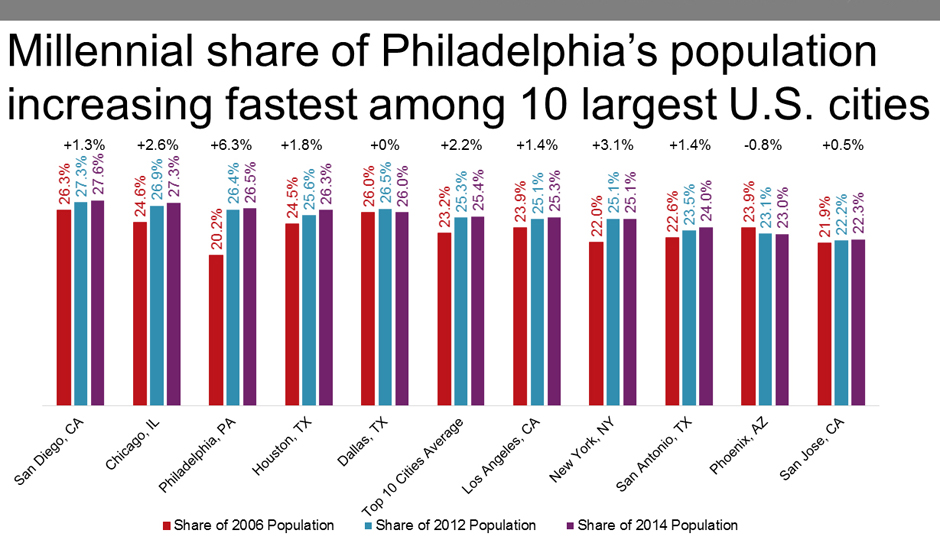Like what you’re reading? Stay in touch with BizPhilly — here’s how:
Philly’s Millennial Population Growing Fastest Among 10 Largest U.S. Cities
Source: JLL Research, U.S. Census Bureau.
Philadelphia’s millennial population is increasing fastest among the 10 largest U.S. cities, according financial and professional services firm JLL and data from the U.S. Census.
Between 2006 and 2014, Philly added 120,600 millennials, a surge of 41.2 percent. Today, millennials (ages 20-34 years old), make up 26.5 percent of the citywide population.
The next fastest grower was New York, which went from 22 percent to 25.1 percent in the same span. That was followed by Chicago and Houston. The average for all 10 cities was a rise from 23.2 percent to 25.4 percent.
Philadelphia has become an ideal destination for millennials — both children of Philly’s Baby Boomers who are now growing into their 20s and 30s and choosing to stay here, and young people moving to Philly for college or work.
“It’s not surprising that people in their early 20s to late 20s think Philly is a great place to live,” said Susan Mudambi, an associate professor of marketing at Temple University’s Fox School of Business. “Philly is more attractive to that age group, because there’s more active restaurant scenes, and there’s a lively arts-and-culture scene. The city is also very friendly to runners, cyclists and people who like outdoor activities.”
From a business perspective, growing millennial populations help shape neighborhoods.
“They can be young, talented, enthusiastic workers who spend a lot of money on restaurants and contribute to volunteering efforts and starting businesses,” she said.
Real estate developers are betting that millennial-friendly neighborhoods — such as Northern Liberties, Fairmount and University City — will continue to thrive.
“There’s so much construction and investment,” she said. “I think the gamble there is that they’re betting these people in their late 20s and early 30s are going to stick around.”
The city’s booming technology industry also sees a boost because the millennial population is growing but rents are still relatively low compared to other cities. But will Philly be able to retain millennials as they age?
“Once people step into their mid ages and have children, they start to worry about their children’s education, their safety and future,” said Mudambi. “The challenge is to keep them here and to find ways that make living in the city continue to be attractive. That to me is the most exciting unknown.”
It should be noted that the largest growth of millennial share in Philly occurred between 2006 and 2012, jumping from 20.2 percent to 26.4 percent in that time span. After that, the proportion had remained relatively stable.
“It’s a dramatic percentage increase — and there’s no one reason for it,” said Mudambi. “It’ll be interesting to see if we can stay at that [level] and [start to] build on it.”



